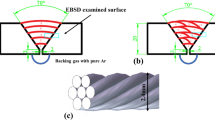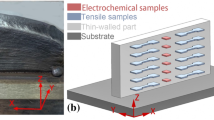Abstract
Premature corrosion in the form of longitudinal cracking in a high-frequency (HF) induction seam-welded steel pipe occurred after just 24 months in service. The failed pipe was investigated to reveal the main cause of its failure, and the results of microstructural examinations (light optical microscopy, scanning electron microscopy with energy-dispersive spectrometry) suggest that the failure resulted from an HF induction welding process defect—a so-called cast weld, that is, a huge number of iron oxides in the weld line caused by insufficient ejection of the molten metal from the bond line.
Similar content being viewed by others
Avoid common mistakes on your manuscript.
Introduction
A 3″ (fi 88.9 × 3.87 mm) high-frequency induction welded pipe made of S195 steel carrying hot water (70/50 °C at 4 bar pressure) failed by longitudinal cracking after just 24 months in service, as shown in Fig. 1.
Visual inspection of the failed pipe showed that the rupture is located within the seam weld line, similarly to the case presented in the work [1], which focused on longitudinal cracks in electric resistance welded (ERW) steel pipes immediately after quenching and tempering processes. As stated by Kaba et al. [1], the cracks in the quenched and tempered ERW steel pipes could be correlated with the combination of coarse manganese silicate type complex oxide formation in the weld seam and high thermal stresses induced by rapid cooling from the austenitization temperature during quenching. The HF ERW method is classified into the HF induction method and the HF resistance welding method, depending on the method employed in the application of HF current to the workpiece. Usually, HF welding is a type of ERW process for steel pipes with walls of ordinary thickness or thin walls [2, 3]. In the HF induction welding method, an induction coil is used to induce an HF current to generate heat. In HF resistance welding, on the contrary, a contactor is applied to the workpiece to provide the current directly [4, 5]. The high-frequency current, introduced with an induction coil around the pipe, flows only on the surface of the pipe (skin effect) and the edges of the coil material are heated up to high temperatures then forged with external rolls and some metal is expelled (squeezed out) together with the iron oxides formed during heating [6].
In the case of the pipe examined in this study, the longitudinal crack occurred after just 2 years of service and the pipe itself was not subjected to heat treatment after HF induction welding. However, since the longitudinal crack in the tested pipe occurred in the weld line, the microstructure of the bond line was examined using both optical microscopy and scanning electron microscopy with energy-dispersive spectrometry to determine the cause of the failure.
Experimental and results
In the process of preparing metallographic samples, in the supplied pipe sections, macroscopic cracks were observed along the weld line (Fig. 2a) and there was a progressive corrosion attack along the weld line in the sample cut away from the leakage point (Fig. 2b).
No extruded metal was observed at either the inner or the outer surface. This suggests that the extruded metal was removed mechanically (by cutting) at the end of the HF seam welding process.
The microstructure of the sample taken from the place marked in Fig. 2b (corrosion attack along the weld line) is shown in Fig. 3 (non-etched sample).
As can be seen in Fig. 3, there are many inclusions along the weld line. These inclusions are also visible on micrographs of the etched specimens (2% nital), shown in Fig. 4.
The presence of numerous inclusions in the weld line was also confirmed in an additional sample taken further away from the leak location, as shown in Fig. 5.
The nature of the numerous inclusions observed in the weld line was analyzed using a scanning electron microscope. Figure 6 shows the images obtained by scanning electron microscopy in the weld line.
The results of energy-dispersive spectroscopy (EDS) microanalysis of the inclusions visible in Fig. 6 are presented in Figs. 7, 8, 9 and 10. The structural examinations conducted by use of EDS (Figs. 7b, 8b, 9b and 10b) show that inclusions observed in the weld line are iron oxides.
The results of EDS microanalysis of the inclusion visible in Fig. 6a
The results of EDS microanalysis of the inclusion visible in Fig. 6b
The results of EDS microanalysis of the inclusion visible in Fig. 6c
The results of EDS microanalysis of the inclusion visible in Fig. 6d
Conclusion
In the present paper, microstructural examinations (light optical microscopy, scanning electron microscopy with energy-dispersive spectrometry) were performed to reveal the main cause of premature corrosion in the form of longitudinal cracking in a high-frequency (HF) induction seam-welded steel pipe after just 2 years of service. The major findings include:
-
Macroscopic observations of the failed pipe showed that the rupture is located within the seam weld line.
-
Metallographic examinations revealed a huge number of non-metallic inclusions in the weld line along the entire thickness of the pipe wall in all tested samples.
-
Scanning electron microscopy observation with energy-dispersive spectrometry results showed that these non-metallic inclusions present in the weld line are iron oxides.
-
The progressive corrosion attack along the iron oxide clusters in the weld line further away from the leak location was observed.
-
The initiation and propagation of corrosion cracks occur at the inner surface of the pipe.
It is known that non-metallic inclusions can affect the corrosion resistance of steel and in particular its resistance to pitting corrosion [7, 8]. Additionally, the clustered non-metallic inclusions (iron oxides in this study) significantly reduce the fracture toughness of the seam weld, leading to the formation of longitudinal cracks. This large amount of iron oxides observed in the weld line resulted in premature corrosion in the form of longitudinal cracking that can only be related to one of the high-frequency welding defects known as a cast weld [3]. A cast weld is the result of failure to eject all of the molten metal from the bond plane. The remaining cast metal on the bond plane likely contains metal oxides. Prevention of a cast weld is possible by increasing squeeze out or increasing the strip width.
References
M. Kaba, M. Altay, H. Çimenoğlu, An investigation on the longitudinal cracking of electric resistance welded steel pipes. J. Fail. Anal. Prev. 20, 657–662 (2020)
D. Kim, T. Kim, W. Park, K. Sung, M. Kang, C. Kim, C. Lee, S. Rhee, Estimation of weld quality in high-frequency electric resistance welding with image processing. Weld. J. 86(3), 71–79 (2007)
R.K. Nichols, Common HF Welding Defects. Technical Paper, Thermatool Corporation, USA (undated)
R.L. O’Brien (eds), Welding Process Vol. 2, 8th edn (Welding Handbook, 1991), pp. 652–669
K. Weman, Welding Processes Handbook (CRC Press, Boca Raton, 2003)
Ö.E. Güngör, P. Yan, P. Thibaux, M. Liebeherr, H.K.D.H. Bhadeshia, D. Quidort, Investigations into the microstructure—toughness relation in high frequency induction welded pipes, in Proceedings of the 8th International Pipeline Conference IPC2010, September 27 – October 1, Calgary, Alberta, Canada (2010)
S. Zheng, C. Chen, L. Chen, Influence of S contents on the hydrogen blistering and hydrogen induced cracking of A350LF2 steel. Mater. Sci. Appl. 2, 917–921 (2011)
T.V. Shibaeva, V.K. Laurinavichyute, G.A. Tsirlina, A.M. Arsenkin, K.V. Grigorovich, The effect of microstructure and non-metallic inclusions on corrosion behavior of low carbon steel in chloride containing solutions. Corros. Sci. 80, 299–308 (2014)
Author information
Authors and Affiliations
Corresponding author
Additional information
Publisher's Note
Springer Nature remains neutral with regard to jurisdictional claims in published maps and institutional affiliations.
Rights and permissions
Open Access This article is licensed under a Creative Commons Attribution 4.0 International License, which permits use, sharing, adaptation, distribution and reproduction in any medium or format, as long as you give appropriate credit to the original author(s) and the source, provide a link to the Creative Commons licence, and indicate if changes were made. The images or other third party material in this article are included in the article's Creative Commons licence, unless indicated otherwise in a credit line to the material. If material is not included in the article's Creative Commons licence and your intended use is not permitted by statutory regulation or exceeds the permitted use, you will need to obtain permission directly from the copyright holder. To view a copy of this licence, visit http://creativecommons.org/licenses/by/4.0/.
About this article
Cite this article
Tyrala, D., Pawlowski, B. Failure Analysis of Premature Corrosion of HF Seam-Welded Steel Pipe in Central Heating System. J Fail. Anal. and Preven. 21, 772–778 (2021). https://doi.org/10.1007/s11668-021-01134-6
Received:
Revised:
Accepted:
Published:
Issue Date:
DOI: https://doi.org/10.1007/s11668-021-01134-6














